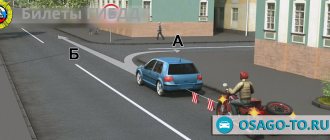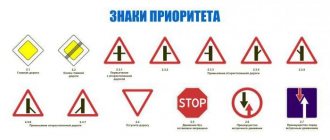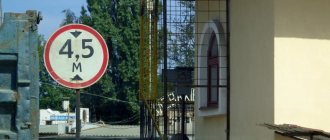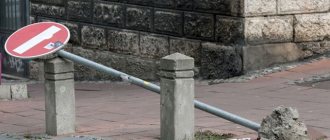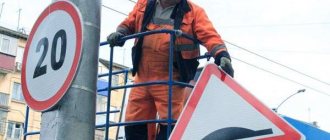Which driver making a turn is breaking the Rules?
| 1. | Only the driver of a passenger car. |
| 2. | Only a motorcyclist. |
| 3. | Both are violating. |
| 4. | Both do not violate. |
Drivers are required to comply with the requirements of traffic lights, road signs and markings. In this situation, road sign 4.1.1 “Move straight ahead” instructs you to move only straight. Traffic light signals only override priority signs.
Purpose of sign 4.1.1
Many drivers in Russia do not understand why the sign 4.1.1 Drive straight is installed on the roads, and some simply ignore it. In fact, you may be fined for violating the requirements of the sign if the maneuver is recorded on a video camera or you are noticed by traffic police officers.
In some cases, this sign allows a right turn, but many do not know in what cases such a maneuver is allowed or prohibited. For example, when driving under sign 4.1.1, it may be necessary to turn right into the yard or gas station. In this case, you do not need to let anyone pass to complete the maneuver, that is, you simply turn and do not interfere with anyone.
Many motorists who argue with traffic inspectors try to explain that they were oriented incorrectly and were unable to determine the coverage area of the installed sign. This shouldn't really be a problem since there aren't many options.
When this road sign is placed in front of an intersection, its effect extends to a specific road intersection. If the sign is located outside the intersection on a straight section, it prohibits left turns and U-turns until the nearest intersection, after which the sign will no longer be valid.
Under the road sign Go straight ahead there may be a sign with a picture of a certain type of vehicle (for example, a heavy truck). Accordingly, it is trucks that are covered by the sign, while drivers of passenger cars can make U-turns and turns without violating traffic rules.
What should you do if you need to turn around?
| 1. | Drive straight and turn around at the next intersection. |
| 2. | Drive straight and turn around at the intersection. |
| 3. | Turn around at this intersection if there are no other vehicles at it. |
At this intersection, the road being crossed has one carriageway, and therefore the “Go straight” sign prohibits you from making a U-turn at the intersection. This sign does not impose any restrictions on the section of road following the intersection, where you can turn around. The correct answer is: Drive straight and turn around at the intersection.
Traffic rules questions based on the “Go straight ahead” sign
Road sign action: straight ahead
2
Are you allowed to continue driving at the intersection?
- Just straight
- Straight and left
- Forward and backward
- In any direction
Discuss a question
2
You can continue driving at the intersection:
- Only in direction B
- In directions A and B
- In directions B and C
Discuss a question
2
Which courtyard can you enter in this situation?
- Just to the left in the yard
- Just into the yard to the right
- At any
- Turns into courtyards are prohibited
Discuss a question
2
You can perform a reversal:
- Only along trajectory A
- Only along trajectory B
- Along any of the indicated paths
Discuss a question
2
Is it possible for you to enter the yard after the intersection?
- Can
- Yes, if you live in this house
- It is forbidden
Discuss a question
2
Which of the warning and prohibition signs are temporary?
- Mounted on a portable stand
- Having a yellow background and installed in road work areas
- All listed
Discuss a question
2
You can continue at the following intersection:
- Only in direction B
- Only in direction B
- In any of the directions indicated
Discuss a question
2
What should you do if you need to turn around?
- Turn around at this intersection if there are no other vehicles at it
- Drive straight and turn around at the intersection
- Drive straight and turn around at the next intersection
Discuss a question
9
Is it permissible for a driver to reverse towards a passenger on this stretch of road?
- Allowed
- Allowed if the driver is driving a passenger taxi
- Forbidden
Discuss a question
Which of the following directions can you continue driving at the next intersection?
| 1. | A or B. |
| 2. | Only B. |
| 3. | In all. |
The “Go straight ahead” sign, installed at the beginning of the road section (behind the intersection), prohibits left turns and U-turns in this section. The effect of the sign in such cases extends to the nearest intersection in the direction of travel, maneuvers at which are not limited in any way by this sign. Therefore, you can move in any of the above directions.
Answers to examination questions for sign 4.1.1 “Move straight ahead”
Ticket No. 13 Question No. 2
What should you do if you need to turn around?
1. Turn around at this intersection if there are no other vehicles at it.
2. Drive straight and turn around only at the next intersection.
3. Drive straight and turn around after the intersection.
Comment: Sign 4.1.1 “Move straight ahead” applies to the first intersection and prohibits a U-turn; you must drive straight through the intersection and then turn around.
Ticket No. 15 Question No. 2
In which directions are you allowed to continue driving at the intersection?
1. Only B.
2. A or B.
3. B or V.
Comment: Sign 4.1.1 “Move straight” is only valid at the first intersection of roadways in front of which it is installed. You are only prohibited from turning right onto the first roadway. In other directions you can continue moving.
Question No. 16 Question No. 2
Which courtyard can you enter in this situation?
1. Just go left into the courtyard.
2. Just go into the courtyard to the right.
3. Anytime.
4. Turns into courtyards are prohibited.
Comment: Sign 4.1.1 “Move straight”, installed behind the intersection, prohibits left turns into courtyards and U-turns in this area, but does not restrict entries into courtyards located on the right.
Ticket No. 17 Question No. 9
What trajectory are you allowed to make a turn on?
1. Only at the intersection - along trajectory A.
2. Only before the intersection - along trajectory B.
3. Along any of the proposed trajectories.
4. Not along any of the proposed trajectories.
Comment: Sign 4.1.1 “Go straight” is installed at the beginning of this section of the road, and its effect ceases at the intersection following it. This means that you can only make a turn along trajectory A. You cannot turn around along trajectory B, since the sign’s instructions are still in effect in this place.
Ticket No. 19 Question No. 2
In which directions are you allowed to continue driving in a passenger car?
1. Just straight.
2. Only left or right.
3. In any.
Comment: Plate 8.4.1 “Type of vehicle” with a picture of a truck applies the mandatory sign 4.1.1 “Driving straight” only to trucks with a permissible maximum weight of more than 3.5 tons. Thus, you can drive through the intersection in any direction .
Ticket No. 20 Question No. 2
Are you allowed to enter the yard beyond the intersection?
1. Yes.
2. No.
3. Yes, only if you live in this house.
Comment: Sign 4.1.1 “Move straight” in this case only applies to the intersection in front of which it is installed, and does not limit maneuvers on the subsequent section of the road, where you can enter the yard located on the left.
Ticket No. 22 Question No. 2
In which directions are you allowed to continue driving at the intersection?
1. Just straight.
2. Straight or left.
3. Forward or reverse.
Comment: Sign 4.1.1 “Move straight ahead” allows you to continue moving in the forward direction at this intersection only.
Ticket No. 24 Question No. 7
What mistake does a driver make when entering a yard?
1. Turn in the area covered by the “Go straight ahead” sign.
2. Turns without turning on the direction indicators.
3. Makes both of the listed mistakes.
Comment: Sign 4.1.1 “Go straight”, installed at the beginning of the road section, does not prohibit right turns into courtyards and other areas adjacent to the road. However, before performing the maneuver, it is necessary to signal a right turn, which the driver did not do.
Ticket No. 28 Question No. 9
Is it permissible for a driver to reverse towards a passenger on this stretch of road?
1. Yes.
2. No.
Comment: Sign 4.1.1 “Move straight ahead” does not prohibit reversing.
Ticket No. 30 Question No. 2
What trajectory can you use to make a turn?
1. Only according to A.
2. Only according to B.
3. For any.
Comment: The road adjacent to the left has two carriageways, and the sign 4.1.1 “Move straight ahead” applies only to the first intersection of the carriageways in front of which it is installed, prohibiting left turns and U-turns here, and at the second intersection there are no restrictions on maneuvers, and here you can turn around (trajectory B). The correct answer is - Only according to B.
Ticket No. 35 Question No. 2
Which of the following directions can you continue driving at the next intersection?
1. Only B.
2. A or B.
3. In all.
Comment : Sign 4.1.1 “Move straight”, installed at the beginning of the road section (behind the intersection), prohibits left turns and U-turns on this section. The effect of the sign in such cases extends to the nearest intersection in the direction of travel, maneuvers at which are not limited in any way by this sign. Therefore, you can move in any of the above directions.
What trajectory are you allowed to make a turn on?
| 1. | Only according to A. |
| 2. | Only according to B. |
| 3. | None of the proposed ones. |
The “Go straight” sign is valid only at the nearest intersection of the roadways in front of which it is installed (up to the dividing strip). Turn around at the second intersection, i.e. along trajectory A, allowed.
Methods of application
It should be noted right away: sign 4.1.1 “Drive straight” does not apply to all cars. It may be ignored by route vehicles. But ordinary, ordinary drivers - no. Also, sometimes restrictions are lifted from vehicles with special signals (fire department, ambulance, etc.). No more exceptions.
Sometimes the “Go straight” sign is prohibitive. It indicates that the motorist has no right to make U-turns or turn in a particular area. This type of action is usually observed at intersections. And in this case, the sign is installed exclusively on the dividing strip.
In which directions are you allowed to continue driving at the intersection?
| 1. | A or B. |
| 2. | B or V. |
| 3. | Only B. |
At this intersection, the road being crossed has two carriageways; the “Go straight” sign is valid only for the first intersection of carriageways in front of which it is installed. Therefore, you are only prohibited from turning right onto the first carriageway (direction B). The correct answer is A or B.
Road sign traffic right in the rules of the road
Mandatory road sign 4.1.1 Driving straight allows traffic only in the straight direction indicated by the arrow on the sign.
A mandatory road sign 4.1.1 Go straight may be used with an arrow configuration corresponding to the required direction of travel at a particular intersection.
Effect of a mandatory road sign 4.1.1 Traffic directly applies to the intersection of roadways in front of which the sign is installed
Effect of a mandatory road sign 4.1.1 Traffic directly applies to the intersection of roadways in front of which the sign is installed.
The effect of the mandatory road sign 4.1.1 Direct movement, installed at the beginning of the road section, extends to the nearest intersection. The sign does not prohibit turning right into courtyards and other areas adjacent to the road.
The effect of the mandatory road sign 4.1.1 Traffic does not directly apply to route vehicles.
Which courtyard can you enter in this situation?
| 1. | Just to the left into the courtyard. |
| 2. | Just into the courtyard to the right. |
| 3. | At any. |
| 4. | Turns into courtyards are prohibited. |
The “Go straight ahead” sign, installed at the beginning of the road section (behind the intersection), prohibits left turns into courtyards and U-turns in this section, without limiting entries into courtyards located on the right.
Road sign 4.1.1 “Go straight”
The road sign “Go straight” with number 4.1.1 refers to the mandatory signs of the Rules of the Road and establishes the permitted direction. The sign does not apply to route vehicles.
If the “Go straight” sign is installed before the intersection of roadways
The first – the main application option – is before crossing roadways. The sign indicates the only permitted direction is directly through the nearest roadway intersection.
After crossing, the sign's effect ceases. Is it possible to turn left or turn around at an intersection? Yes, any maneuvers are allowed if they are not limited by other requirements of the Rules.
Sign 4.1.1, like other signs, can also be used in front of roads with two carriageway intersections. In this case, mandatory signs are installed before each intersection at the intersection.
The straight ahead sign indicates the only permitted direction, straight through the nearest intersection of roadways
If the “Go straight” sign is installed after an intersection or on a dividing strip
The second option is to install a sign at the beginning of a certain section of the road. In this case, the sign is already in effect throughout the entire section up to the intersection. That is, this sign does not apply to intersections and intersections of roadways.
The sign does not prohibit right turns into courtyards or adjacent areas (gas stations, businesses, etc.). Turning left and making a U-turn before the next intersection is prohibited.
What trajectory are you allowed to make a turn on?
| 1. | Only at the intersection - along trajectory A. |
| 2. | Only before the intersection - along trajectory B. |
| 3. | Along any of the proposed trajectories. |
| 4. | Not along any of the proposed trajectories. |
The “Go straight ahead” sign is installed at the beginning of this section of the road, and its effect ceases at the intersection following it. This means that you can only make a turn along trajectory A. You cannot turn around along trajectory B, since the sign’s instructions are still in effect in this place.
In which directions are you allowed to continue driving in a passenger car?
| 1. | Just straight ahead. |
| 2. | Only left or right. |
| 3. | In any. |
A “Vehicle Type” plate with a picture of a truck applies the “Go Straight” sign only to trucks with a maximum permissible weight of more than 3.5 tons. Thus, you can drive through the intersection in any direction.
Sign on traffic rules tickets
Which driver making a turn will violate the Rules?
More details
What should you do if you need to turn around?
More details
You can continue driving at the intersection:
More details
Which courtyard can you enter in this situation?
More details
On what trajectory do you have the right to make a turn?
More details
In which direction can you continue driving in a car?
More details
Is it possible for you to enter the yard after the intersection?
More details
What mistake does a driver make when entering a yard?
More details
You are allowed to continue driving a truck with a permissible maximum weight of no more than 3.5 tons:
More details
On what trajectory are you allowed to make a turn?
More details
Prescriptive signs include that category of traffic rules signs, the purpose of which is to notify drivers about the direction of travel, as well as about the minimum speed limit, entry into an area with a pedestrian or bicycle path with combined traffic or separated traffic. Mandatory signs also include signs that indicate the direction of vehicles carrying dangerous goods.
It should be remembered that the actions of prescriptive signs indicating movement in a certain direction are valid until the nearest intersection, and the actions of signs indicating movement to the right or left do not apply to route vehicles.
It is quite easy to distinguish the category of mandatory signs from others, since the color scheme of all these traffic rules signs contains light blue. Also, the images on the mandatory signs are quite simple, and you will not have much difficulty learning them and recognizing them on the road.
Are you allowed to enter the yard beyond the intersection?
| 1. | Yes. |
| 2. | No. |
| 3. | Yes, only if you live in this house. |
The “Go straight ahead” sign in this case only applies to the intersection in front of which it is installed, and does not restrict maneuvers on the subsequent section of the road, where you can enter the yard located on the left.
What mistake does a driver make when entering a yard?
| 1. | Turns in the area covered by the “Go straight ahead” sign. |
| 2. | Turns without turning on the direction indicators. |
| 3. | Makes both of the above mistakes. |
Answer.
- The “Go straight” sign installed at the beginning of the road section does not prohibit right turns into courtyards and other areas adjacent to the road.
- However, before performing the maneuver, it is necessary to signal a right turn, which the driver did not do.
Appendix 1. Road signs. 4. Prescriptive traffic rules theory
| 4.1.1 “Move straight”, 4.1.2 “Move right”, 4.1.3 “Move left”, 4.1.4 “Move straight or right”, 4.1.5 “Move straight or left”, 4.1.6 “Move right or left." Driving is permitted only in the directions indicated by arrows on the signs. Signs that permit a left turn also permit a U-turn (signs 4.1.1 - 4.1.6 with a configuration of arrows corresponding to the required directions of movement at a particular intersection can be used). Signs 4.1.1 - 4.1.6 do not apply to route vehicles. The effect of signs 4.1.1 - 4.1.6 extends to the intersection of roadways in front of which the sign is installed. The effect of sign 4.1.1, installed at the beginning of a section of road, extends to the nearest intersection. The sign does not prohibit turning right into courtyards and other areas adjacent to the road. 4.2.1 “Detour around obstacles on the right”, 4.2.2 “Detour around obstacles on the left”. Detour is permitted only from the side indicated by the arrow. 4.2.3 “End of the maximum speed limit zone.” 4.3 “Roundabout”. Movement is permitted in the direction indicated by the arrows. 4.4 “Bicycle path”. Only bicycles and mopeds are allowed. Pedestrians can also move along the bicycle path (in the absence of a sidewalk or pedestrian path). 4.5 “Pedestrian path”. Only pedestrians are allowed to move. 4.6 “Minimum speed limit.” Driving is permitted only at the specified or higher speed (km/h). 4.7 “End of the minimum speed limit zone.” 4.8.1 - 4.8.3 “Direction of movement of vehicles with dangerous goods.” The movement of vehicles equipped with identification signs (information tables) “Dangerous Goods” is permitted only in the direction indicated on the sign: 4.8.1 - straight, 4.8.2 - right, 4.8.3 - left. 1. General provisions (traffic rules theory)2. General duties of drivers (traffic rules theory)3. Application of special signals (traffic rules theory)4. Responsibilities of pedestrians (traffic rules theory)5. Responsibilities of passengers (traffic rules theory)6. Traffic lights and traffic controller signals (traffic rules theory)7. Application of emergency signals and warning triangles (traffic rules theory)8. Start of movement, maneuvering (traffic rules theory)9. Location of vehicles on the roadway (traffic rules theory)10. Speed of movement (traffic rules theory)11. Overtaking, advancing, oncoming traffic (traffic rules theory)12. Stopping and parking (traffic rules theory)13. Driving through intersections (traffic rules theory)14. Pedestrian crossings and stopping places for route vehicles (traffic rules theory)15. Traffic across railway tracks (traffic rules theory)16. Driving on highways (traffic rules theory)17. Traffic in residential areas (traffic rules theory)18. Priority of route vehicles (traffic rules theory)19. Use of external lighting devices and sound signals (traffic rules theory)20. Towing of motor vehicles (traffic rules theory)21. Training driving (traffic rules theory)22. Transportation of people (traffic rules theory)23. Transportation of goods (traffic rules theory)24. Additional requirements for the movement of bicycles, mopeds, horse-drawn carts, as well as the passage of animals (traffic rules theory) Basic provisions for the admission of vehicles for operation and the responsibilities of officials to ensure road safety (traffic rules theory) List of malfunctions and conditions under which the operation of vehicles is prohibited means (traffic rules theory) Appendix 1. Road signs. 1. Warning signs (traffic rules theory) Appendix 1. Road signs. 2. Priority signs (traffic rules theory) Appendix 1. Road signs. 3. Prohibition signs (traffic rules theory) Appendix 1. Road signs. 4. Mandatory signs (traffic rules theory) Appendix 1. Road signs. 5. Signs of special regulations (traffic rules theory) Appendix 1. Road signs. 6. Information signs (traffic rules theory) Appendix 1. Road signs. 7. Service signs (traffic rules theory) Appendix 1. Road signs. 8. Additional information signs (plates) (traffic rules theory) Appendix 2. Road markings and its characteristics. 1. Horizontal markings (traffic rules theory) Appendix 2. Road markings and its characteristics. 2. Vertical markings (traffic rules theory) |
What trajectory can you use to make a turn?
| 1. | Only according to A. |
| 2. | Only according to B. |
| 3. | For any reason. |
The road adjacent to the left has two carriageways, and the sign “Move straight ahead” is valid only at the first intersection of the carriageways in front of which it is installed, prohibiting left turns and U-turns here, and at the second intersection there are no restrictions on maneuvers, and here you can turn around (trajectory B). The correct answer is - Only according to B.
